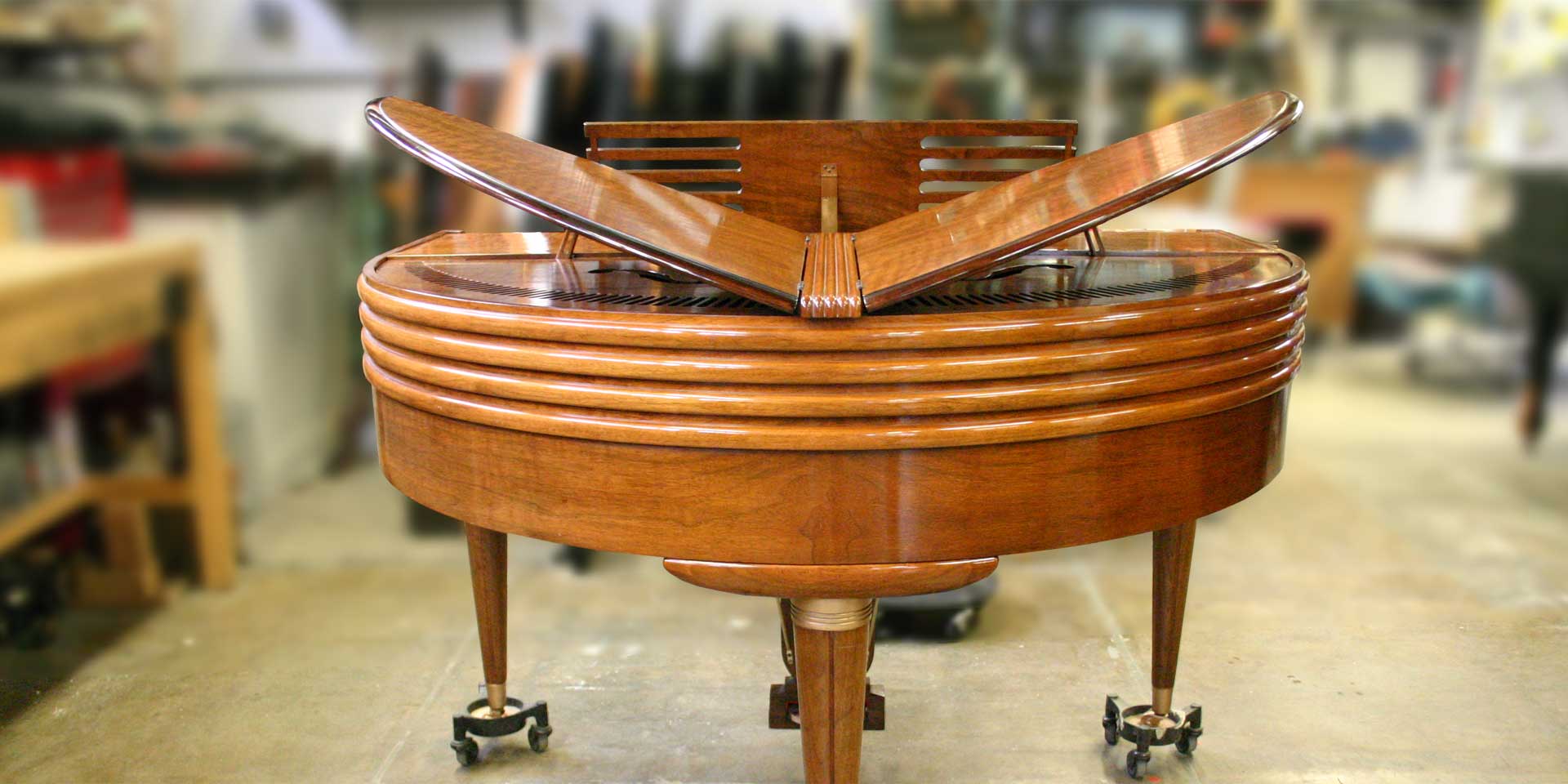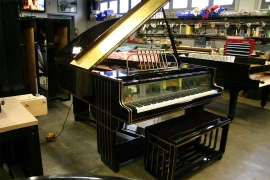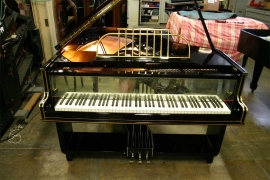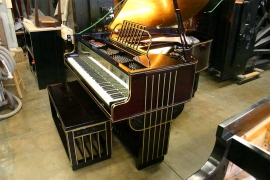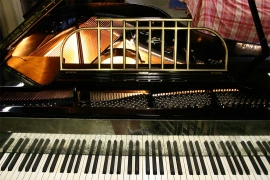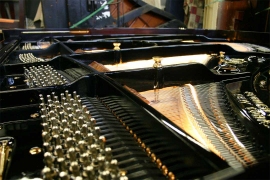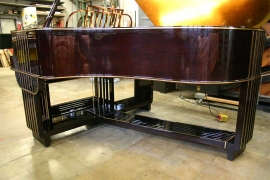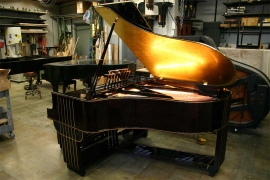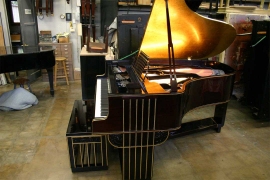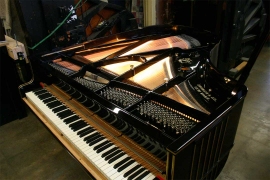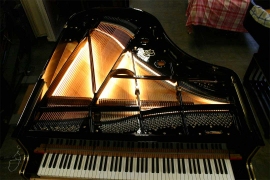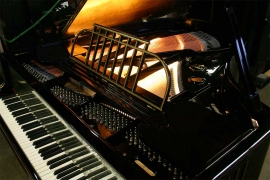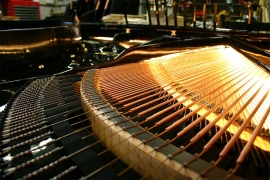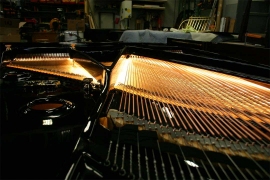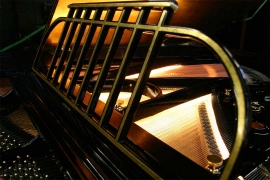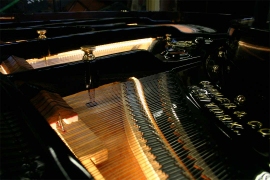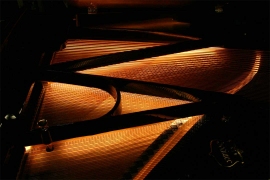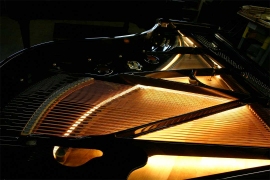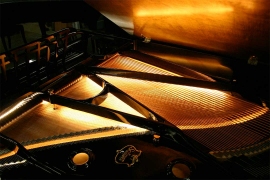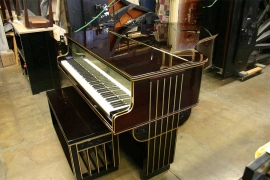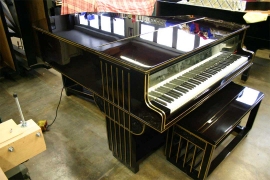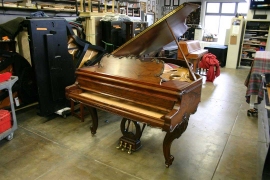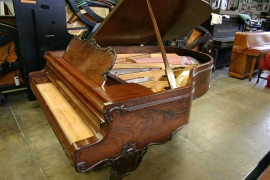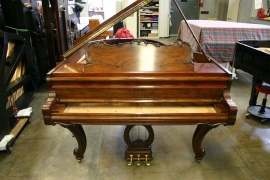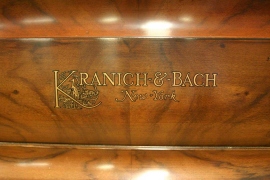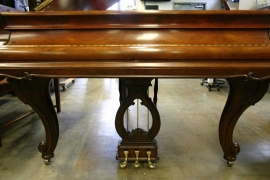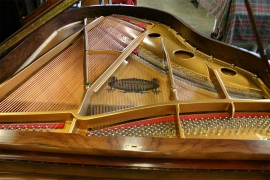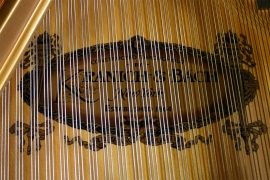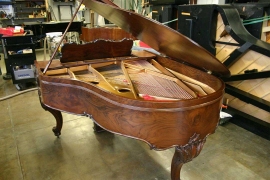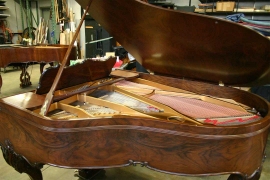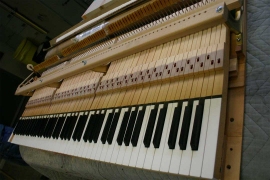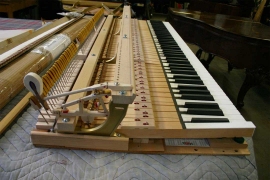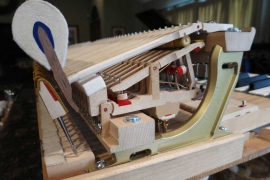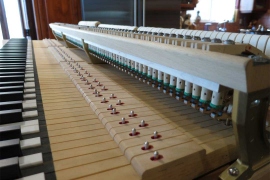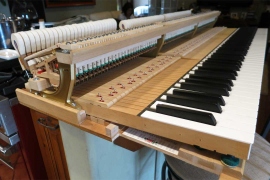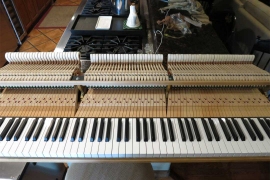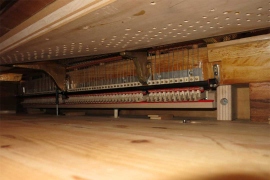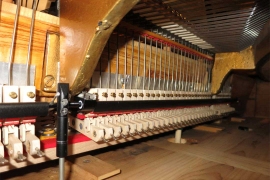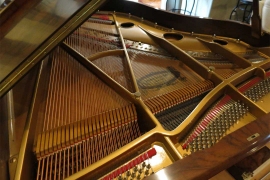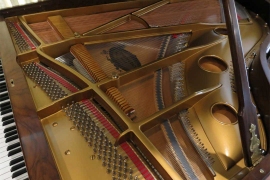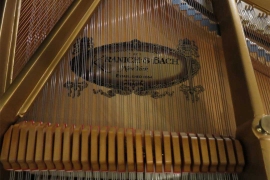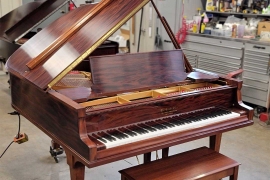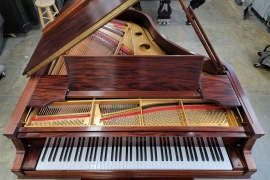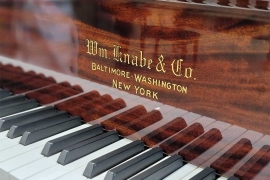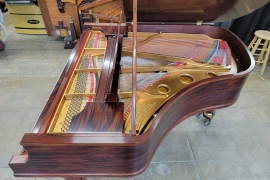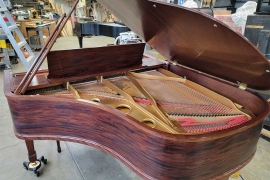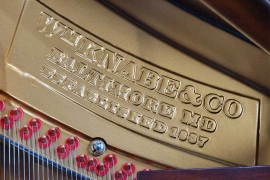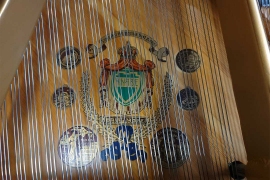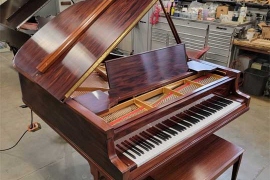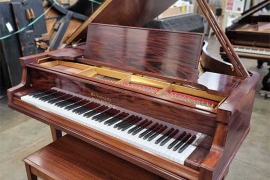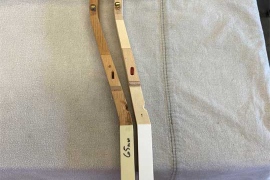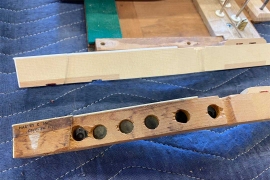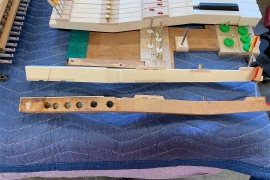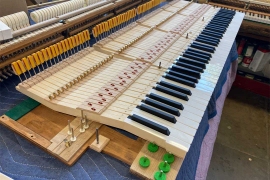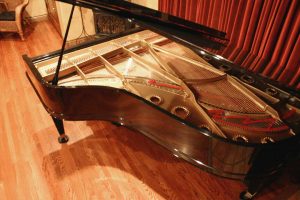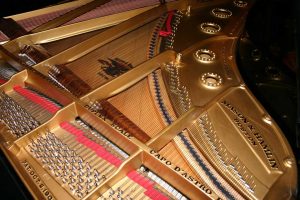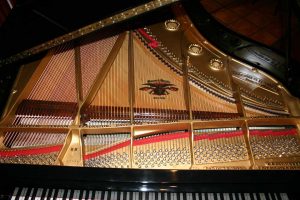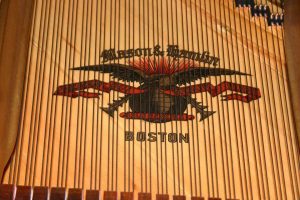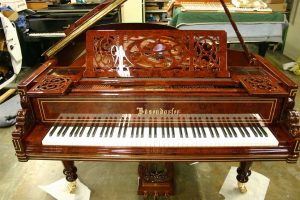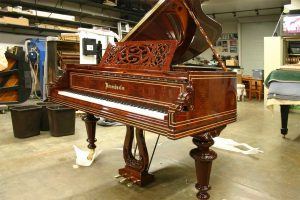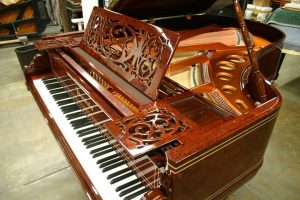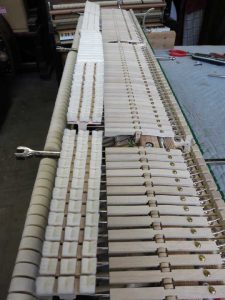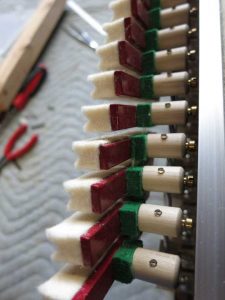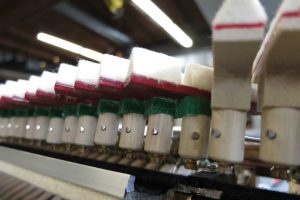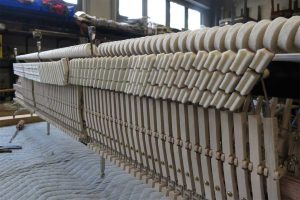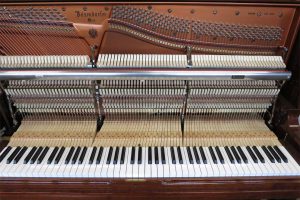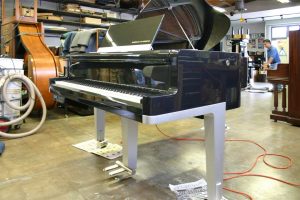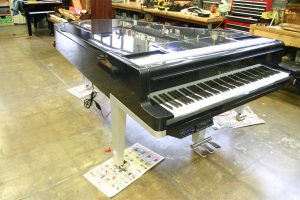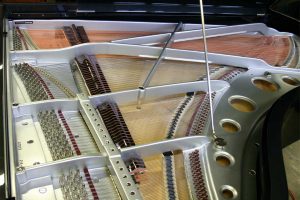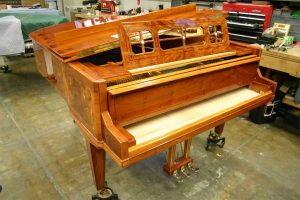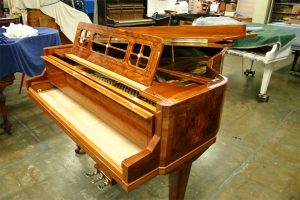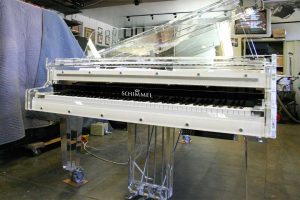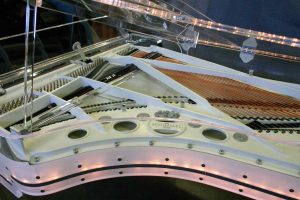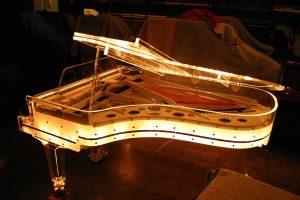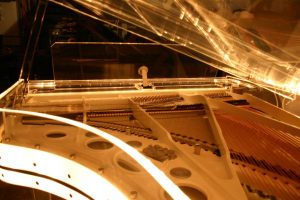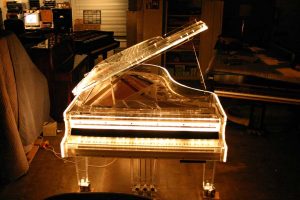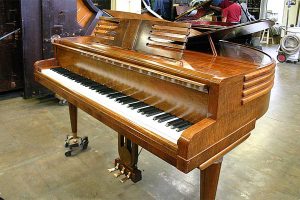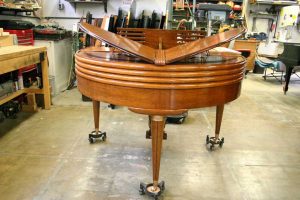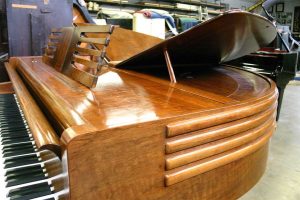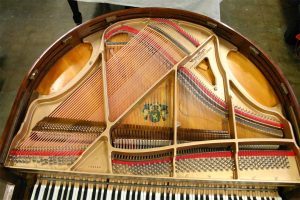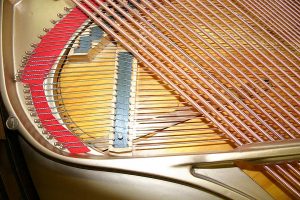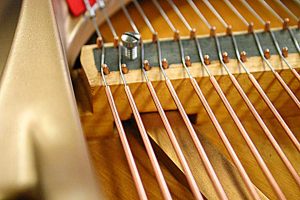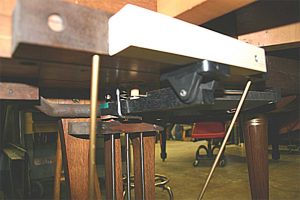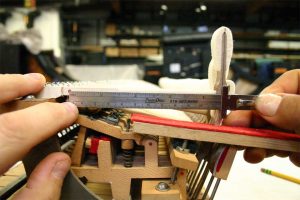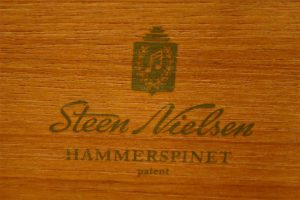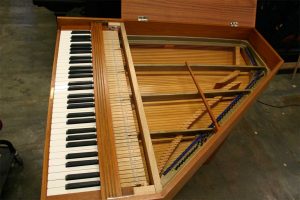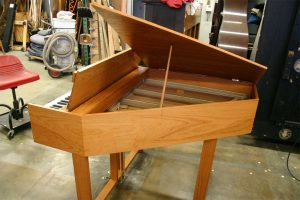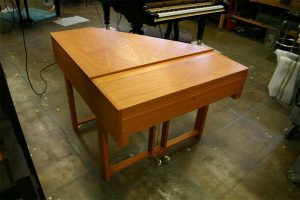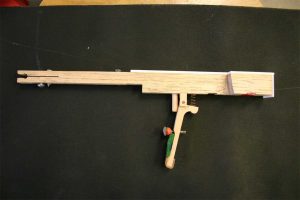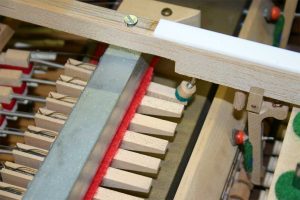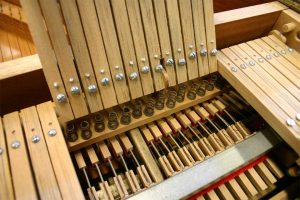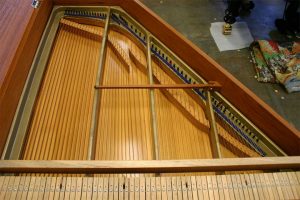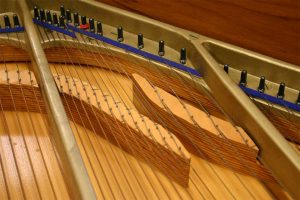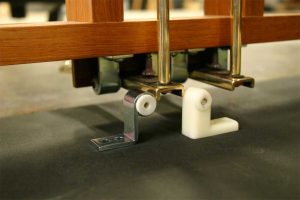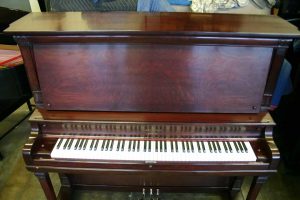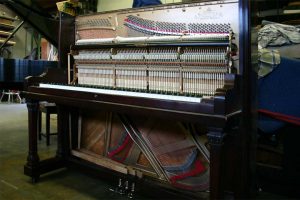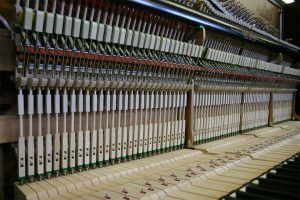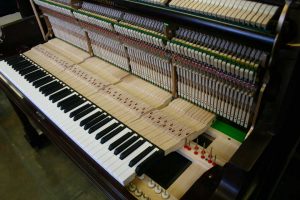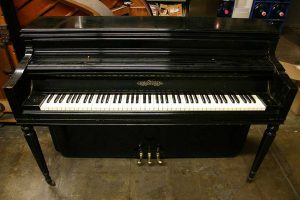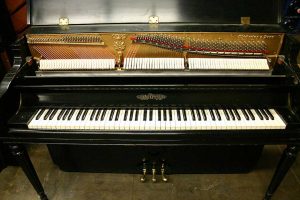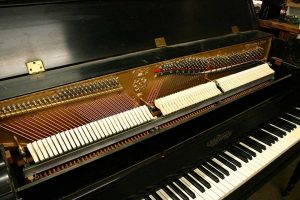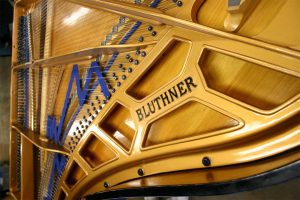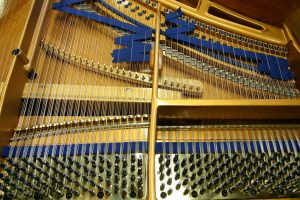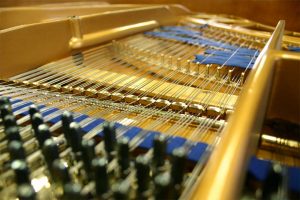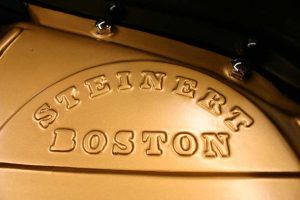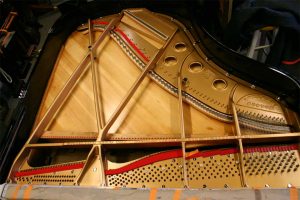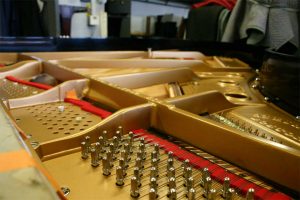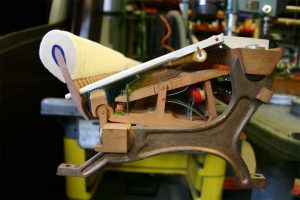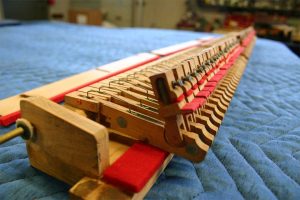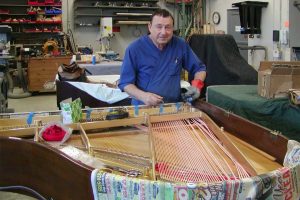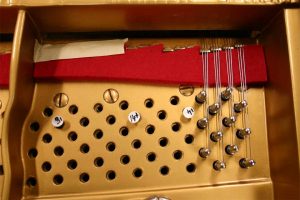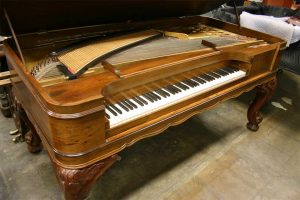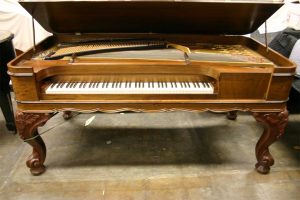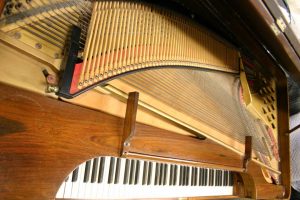Featured Fine Pianos from Around the World
Mason and Hamlin, Bösendorfer, Baldwin, Schimmel, Bluthner, and More…
Images in our Piano Services Gallery can be enlarged by clicking on the image
1930’s Sohmer Deco Art Case Grand Piano
Here we see a fine and well preserved example of a unique Sohmer grand piano in art deco style cabinetry. The client wanted the piano restored both on the inside and the outside, with some very unique requests we were able to perform. The exterior mahogany finish features a high polish finish, with gold leaf accents throughout, an antique mirrored fallboard, and a lighter, natural color interior underside of the lid.
To compliment the beautiful exterior, the cast iron plate was refinished in high gloss black and LED light strips were installed on the underside of the plate struts to highlight the piano interior, and especially the underside of the lid, in the evening hours. Preserving one of these treasures pianos is an honor and we are proud to have put our mark on such a unique instrument!
1917 Kranich and Bach Queen Anne Circassian Walnut Grand
Kranich and Bach pianos are sought after for their incredible belly work and case designs, but with woefully inferior action mechanics that simply do not stand the test of time, they are also known by their common nickname, “Chronically Broke.”
We simply could not let this stunning example end up in a landfill, so a major interior and exterior restoration was undertaken.
The beautiful Circassian walnut was restored to its former glory on the exterior. We then installed a dimensionally duplicated soundboard with all new bridges, and a new lumber core pinblock.
We then had to address the atrocious original action and damper back actions. We decided to produce a completely new action keyset, along with a completely brand new stack to house modern Renner replacement parts, along with a set of new Renner Premium Blue hammers. To compliment the entirely new action, we custom fabricated a new Renner damper tray with installed spoon lifters to enable the ultimate in damper and pedal response.
The end result was a good story you’ll discover in the photo gallery below, a wonderful piano to look at, as well as having playability and tone that any concert artist would be pleased to play!
1924 Knabe 6’4″ Mahogany Grand Piano Restoration
Here we see an excellent example of an original Knabe grand piano that was originally produced with a pneumatic player piano roll system. When it first arrived to our studio, the original system had been replaced with a 1970’s vintage Pianocorder tape player system that was completely inoperative, and which rendered the pedals of the piano unplayable. In addition, the keys themselves had been butchered with excessive leading throughout, weakening the sticks, and making the existing action virtually unplayable.
A new finish on the exterior was desperately needed and applied, and a thorough shimming and epoxy coating of the soundboard panel and bridge repinning and renoching were performed. A new Bolduc lumber core pinblock was also installed. All new dimensionally correct Tokiwa action parts were installed, along with custom made Abel hammers.
A new keyset was also produced, and the key width was expanded to a modern 48 and 3/8″ width, not only to bring the compressed action to the current standard, but to also decrease the amount of dogleg angles of the keysticks themselves. This increases power transmission from the front of the key to the back of the action, and also reduces the wear effect on the keybushings due to the more linear angle of the keys.
To further honor the original intent of the instrument, we installed a brand new Pianodisc Prodigy player piano system and restored all the pedals to proper working order. A stunning result when completed!
Mason and Hamlin Pianos – Classic Hand-Made American Grand Pianos
Above pictures show a classic Mason and Hamlin Model BB grand piano built during the golden era of piano building in 1928. These vintage Mason and Hamlin pianos are built in a similar manner of piano construction as Steinway pianos are. The tone these pianos produce is both powerful and warm, with a very full sustain. They feature very heavy multi-laminate maple rims and pinblock structure, and full perimeter plate castings which are considered some of the heaviest in the industry.
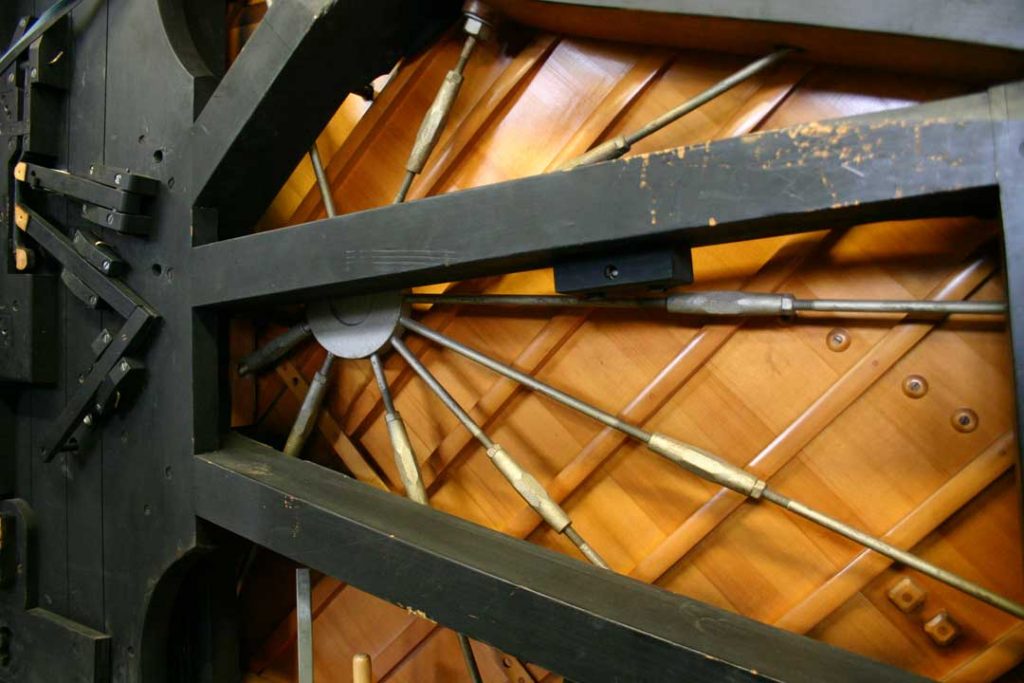
Unique to the Mason and Hamlin piano is the the patented Tension Resonator System. Sometimes called the “spider” under the soundboard, these steel bars are fixed into the rim and belly of the piano, which are all connected by a center “hub.” These bars are tensioned at the factory to help retain the case structure of the piano, and in theory, help retain the crown of the soundboard. These bars are adjusted at the factory to a specific tension and should NEVER be adjusted in the field.
Mason and Hamlin pianos are considered to be one of the best instruments ever produced. Its heavy construction, coupled with extraordinary craftsmanship, make this piano sought after by many pianists. This particular Model BB pictured was in our studio for internal restoration and was owned by the Academy Award winner and multiple nominee, the late Jerry Goldsmith.
Here is an amazing 2014 Bösendorfer Model 130 upright piano that came into our studio for the installation of PianoDisc ProRecord Silent Piano system. Very few pianos are built to Bösendorfer standards nowadays, and to have this build quality available in an upright piano form is extremely rare. Notice the Renner action used in this piano, but in particular, the damper system and components.
Tapered from top to bottom, we see a stunning installation of three-piece flat dampers, 15 ultra-long trichord dampers, and never before seen three-piece bass damper felts with heavy metal backing plates on the heads to insure quick and complete note off performance. All the heads lay perfectly flat to the strings, with perfect lift by each key and complete uniformity with the sustain pedal. This $60,000 instrument will please the most discerning pianist, and the quality, craftsmanship and care used in production is unmatched. A real treat to play!
Bösendorfer – Porsche Designed Grand Piano
This Bösendorfer grand piano designed by F.A. Porsche is another prime example of custom piano building. This sleek piano was in our studio for a PianoDisc installation. Note the use of silver coloring on the plate of the piano, and the unique control pedals on the lyre.
Schimmel Art Case Grand Piano
Not all pianos that come into our studio require complete rebuilding. This Schimmel Art Case Grand Model 175 built in the 1980’s, has spent most of its life in a house by the ocean, and showed signs of brass and string corrosion. After a thorough cleaning, regulation, tuning, and voicing, the piano looked and played as new again.
A Beautiful Schimmel Plexiglas Grand Piano With Lights
Here we see a Schimmel Model 213 in custom Plexiglas® cabinetry. The piano is built with lights throughout the cabinetry that produce a stunning result, especially in darkness. The light invisibly filters directly across the Plexiglas panels, and reflects around all the ends. This particular piano is stellar example of custom piano building! As a side benefit to the use of Plexiglas, the piano actually has enhanced tone because of the extremely solid and reflective properties of the material. It is also amazingly HEAVY! This instrument was in our facility for regulation, voicing, and the installation of a PianoDisc player piano system.
Restoring a Wurlitzer Butterfly Baby Grand Piano
Here is a rare vintage Wurlitzer Butterfly baby grand built in 1938 which was brought to our studio for restringing, new Renner action components, and damper system repairs. Notice the Art-Deco styling of this unusual instrument. This well preserved piano was played extensively and provided years of service to the owner. After thorough repair and cleaning procedures, the piano played like new again. In fact, the playability and tone that was achieved far exceeded our expectations for such an unusually designed piano (see below).
There are some interesting internal features of the famous Wurlitzer Butterfly baby grand piano shown in the four images above. Notice the adjustment screw on the bridge between the first two tenor bass strings in the first two pictures. This screw adjusts pressure on a floating bar that is attached to the soundboard of the piano between the rim and a center point on the soundboard. As the note is played, pressure can be increased or decreased on this bar by turning the screw to achieve optimal tonal output. This is a brilliant design for such a small piano!
Due to this piano’s very small keybed, the factory installed a torsion-bar type sustain pedal. Although it did function, it’s very short design created a very heavy pedal with a horrible mushy feeling. The third picture shows a redesign of this pedal with a new Young Chang sustain pedal component. The damper system now functions like a normal grand piano. We use this type of redesign on many of our piano restorations that have sub-standard pedal components installed from the factory.
The last picture shows a side view of the compressed Wurlitzer Butterfly grand action. Notice the unusual (although fully functional) wippen assembly. These parts are no longer available and must be hand made if lost or broken. Fortunately for this piano, all components were intact and functioning beautifully.
More interesting still is the fitment of the hammers on the shanks. The hammer is hung on the shank at about 4½ inches. This is 5/8″ shorter than most normal grand pianos. These new Renner components were modified at the hexagonal portion of the shank in order to properly hang the hammers. Rare and oddly designed pianos present numerous challenges that must be overcome in order to do a proper piano restoration.
The Steen Nielsen Hammerspinet Hybrid Piano
Here is a superb example of unique and complicated engineering. This Steen Nielsen Hammerspinet at first glance appears to be a harpsichord, but it is far from it. This instrument has many features we have never seen in a piano before. Each key has only one string per note from bass to treble, as well as having all the tuning pins on the rear side of the cabinet, where normally, you would have the hitch pins for the strings. Also, the action and damper lever assembly is entirely under the keys of the piano.
These pictures illustrate the action’s basic function. A normal type jack is connected to the bottom of each key. The key end is connected to a bar as a pivot point and holds the key in position (there are no balance rail pins). As the key is depressed, a let-off button makes contact with a wooden rail, which then trips a pivoting hammershank towards the string. At the same time, another let-off type button depresses the back of a damper lever in the horizontal position, lifting it off the string to allow the note to sound.
The weight of the action is adjusted by a screw under the rear of the key that is in contact with a spiral spring (no key leads are used). The height of each key at rest is controlled by a screw on the top of the key just behind the keytops, that comes in contact with a weighted wooden piece that is part of the piano’s cabinetry. Keydip is controlled with a normal front rail adjustment.
This piano came to our studio on the request to “make it play” and “make the pedals work.” The instrument was completely out of regulation (more than likely by someone who attempted repairs, but had no concept of how the instrument functioned). Also, pedal function was inoperative. After a basic study of the mechanics of the action, a regulation was performed. Pedal functions were restored in part by replacing the pivot points (last image) with steel as opposed to the plastic parts which would bend under the tension of the pedals.
The tone of this piano is unique and similar to upright toy pianos we have worked on in the past. The playability, astoundingly, is quite good! There is good pianissimo to fortissimo control, and note repetition is consistent and quick. As far as we know, this piano is a Danish design.
Complete Action Restoration on 1918 Kurtzmann Upright
Here is a beautiful example of an early 20th Century, high quality upright grand piano. This piano had been used until all of the keytops had worn off, and the keystick material underneath was ground away. All of the original action components had been repaired numerous times, and suffered from cracks and wood rot. The solution was a set of completely new action components including hammers, shanks, butts, damper levers and heads, wippens, and wippen lifter assemblies. Also included was a brand new keyset reproduction that utilized an entirely new keyframe. This was a BIG, heavy piano, and the corresponding tone produced was just as astounding!
Chickering Console Piano Used By Harry Warren Restored
Here we see a wonderful Chickering console piano used by the renowned and prolific songwriter and publisher, Harry Warren. Mr. Warren wrote such hits as Lullaby of Broadway, On the Atchison, Topeka, and the Santa Fe, and You’ll Never Know, which was his biggest seller in sheet music. Other well known tunes penned by Warren include: I Only Have Eyes for You, You Must Have Been a Beautiful Baby, Chattanooga Choo Choo, That’s Amore, and many more. His last hit came in 1957 with An Affair to Remember.
The restoration of the interior of this well-used instrument commissioned by the estate of Mr. Warren included: all new strings and tuning pins, soundboard and bridge work, all new hammers, complete pedal system overhaul, ivory repairs and restoration, and complete action regulation, tuning and custom voicing. Precision Piano Services is proud to have had a hand in restoring this piano for the Warren estate… a wonderful gem and an important piece of musical history.
Restringing a Bluthner Patented “4th String” Grand Piano
This Bluthner was in need of restringing, and was rebuilt with original felt color and blue tuning pins. Note Bluthner’s patented “4th String” in the two treble sections of the piano. This 4th string is designed to vibrate sympathetically with the main 3 strings and add color and depth to the tone of the piano. Approximately half of these 4th strings are tuned exactly one octave higher than the 3 normal strings. Also note the special bridge exclusively used for the 4th string in front of the main bridge (above center).
Steinert Pianos…Mastering the Art of Imitation
Here is a Steinert grand piano…a superb copy of the Steinway, and Mason and Hamlin grand pianos. The plate, stringing scales and construction methods of the body are all very similar to Steinway. The Wessell, Nickel and Gross action used is almost identical to Mason and Hamlin’s design, albeit the wippen spring is the butterfly style used by Steinway, as opposed to Mason’s screw-adjustable wippen spring. Even the damper tray is almost identical to Mason and Hamlin. It appears that the goal of the company was to incorporate the elements of two of the best made and well known pianos of the time, and create their own “hybrid” design.
These types of pianos usually do not stand the test of time as well as their brand name counterparts, but if proper restorative measures are performed, the likely results can be quite extraordinary.
Restringing a Vintage Mason and Hamlin Grand Piano
Here, Giovanni Skilan (1934-2015), is restringing a vintage Mason and Hamlin grand piano in about the middle of the more than 35 years they worked together as father and son in our studio. Giovanni’s legacy lives on in this third generation of providing piano services driven by passionate expertise and craftsmanship.
Predecessor to the Modern Grand Piano…the Square Grand Piano
Historically, these pianos are very important, and well preserved versions like this one should be maintained and well cared for. For the most part, we believe these pianos should be used for historical performances only. They are not appropriate for learning to “play the piano.”
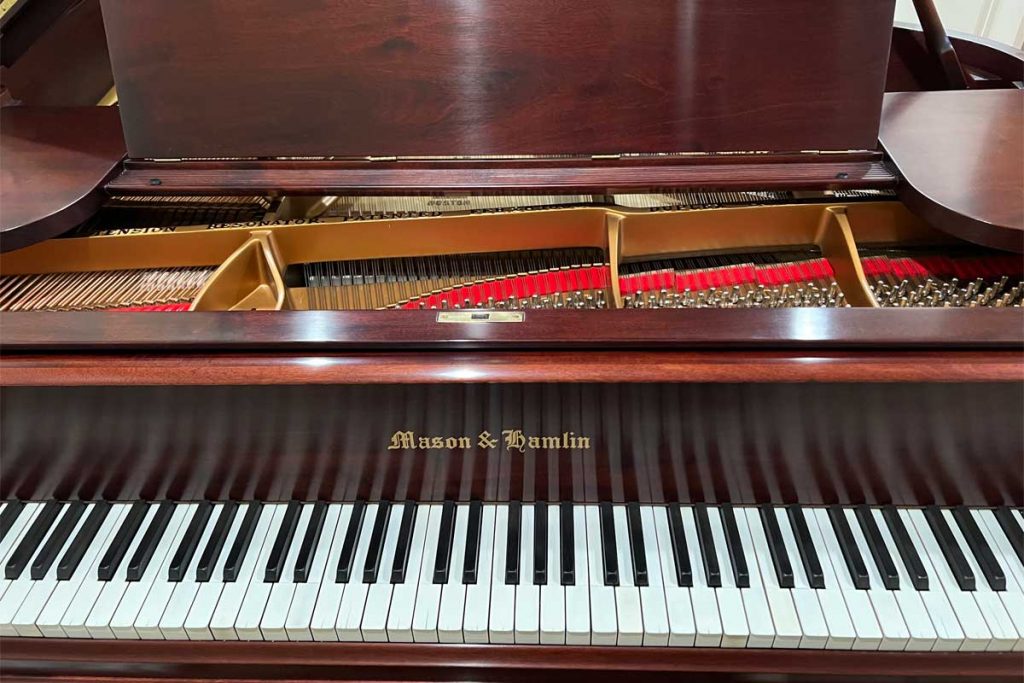
A few years ago, and after considerable research, I consulted with Franco about my much-loved but sadly aging Mason and Hamlin Model A piano. It had been played and played and now, at nearly a hundred years old, it had finally given its all.
After a careful examination of the instrument, Franco gave me an evaluation that listed the work to consider. In the end I decided to go all-in and see my piano restored to an “as new.” I’m so thankful that I made that decision! Under Franco’s exceptionally skilled hand and his years of experience my Mason and Hamlin was restored to its original magnificence.
It’s been several years now and I’m just delighted with my wonderful piano. I always look forward to playing it. Thank you, Franco!
Iva
Mason and Hamlin Model A Grand Piano Restoration

A few years ago, and after considerable research, I consulted with Franco about my much-loved but sadly aging Mason and Hamlin Model A piano. It had been played and played and now, at nearly a hundred years old, it had finally given its all.
After a careful examination of the instrument, Franco gave me an evaluation that listed the work to consider. In the end I decided to go all-in and see my piano restored to an “as new.” I’m so thankful that I made that decision! Under Franco’s exceptionally skilled hand and his years of experience my Mason and Hamlin was restored to its original magnificence.
It’s been several years now and I’m just delighted with my wonderful piano. I always look forward to playing it. Thank you, Franco!
Iva

